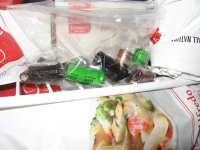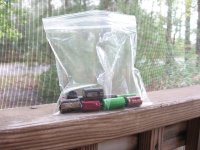I'm not and engineer or specialized in repairing amps but I have golden "hi-end" baby ears plus hi-end speakers and a treated room .
This is more than enough for me as a sound engineer .
The reality will always remain the same that true audio caps being vastly superior.. but if someone lives in a theoretical realm in which he don't have a good reference audio space I understand that angle of view by just presuming that is that way because I know that and that and you don't know that so ...
It's obvious your no engineer. And it's obvious your conceited. Now show us your golden ears. Post some of your music recording/mixes.
Last edited:
It's obvious your no engineer. And it's obvious your conceited. Now show us your golden ears. Post some of your music recording/mixes.
Take a number. There are those of us still waiting for speaker pictures.
First the speakers, then the golden "high end" ears picture.

of course they f---g willSo if a representative from Nichicon read this thread they would agree with your position. Is that what you're saying?

I have been using 10uf 63v electrolytics as input capacitor on amps for 40 years.
In that time I have never had a problem doing that.
In that time I have never had a problem doing that.
I'm not and engineer or specialized in repairing amps but I have golden "hi-end" baby ears plus hi-end speakers and a treated room .
This is more than enough for me as a sound engineer .
The reality will always remain the same that true audio caps being vastly superior.. but if someone lives in a theoretical realm in which he don't have a good reference audio space I understand that angle of view by just presuming that is that way because I know that and that and you don't know that so ...
In what way are they "vastly" improved ?
Lower ESR ? lower inductance ? that about all they can differ by.
I cant see either making much difference.
A lot of these "high cost" components are just snake oil.
If it costs more then it must be better ?
of course they f---g will
Speaker pictures Robby, where are they?
Well if we're not going to get his pictures... back to audio caps.
Before I recap anything, the new caps must go through a three stage process to sound their best.
Stage 1: Cryogenic treatment.

24 hours at most, otherwise they might get eaten accidentally.
Stage 2: Smoothing.

Spending a few hours with some tubes to learn about sounding smooth.
Stage 3: Feeling natural.

Nothing makes the sound more natural than being near nature. If you try this yourself, remember to open the bag for this step.
Before I recap anything, the new caps must go through a three stage process to sound their best.
Stage 1: Cryogenic treatment.

24 hours at most, otherwise they might get eaten accidentally.
Stage 2: Smoothing.

Spending a few hours with some tubes to learn about sounding smooth.
Stage 3: Feeling natural.

Nothing makes the sound more natural than being near nature. If you try this yourself, remember to open the bag for this step.
I trust that bag is biodegradable?
No, you keep using it. The essence of the caps gone before infuses into the new caps...
Do you think this thread will make it to 200?
No, you keep using it. The essence of the caps gone before infuses into the new caps...
Do you think this thread will make it to 200?
We can get it there if we just believe.
a good combination of caps you got there but you can throw them away they are to big ..you need the smallest possible .Well if we're not going to get his pictures... back to audio caps.
Before I recap anything, the new caps must go through a three stage process to sound their best.
Stage 1: Cryogenic treatment.
View attachment 703118
24 hours at most, otherwise they might get eaten accidentally.
Stage 2: Smoothing.
View attachment 703119
Spending a few hours with some tubes to learn about sounding smooth.
Stage 3: Feeling natural.
View attachment 703123
Nothing makes the sound more natural than being near nature. If you try this yourself, remember to open the bag for this step.
The first rule learned here the smaller they are the better will sound .
Also if they explode the small ones won't hurt you that much like the bigger ones .
here is a map of Nichicon caps
The highest grade is KZ the smallest audio grade are called miniature caps .
I've attached links to the data sheets for the FW (standard grade) and KZ (premium grade) Nichicon capacitor ranges. There are observable differences in the specifications, but I admit to not understanding their significance!
Take the 25V capacitors for example:
- The tangent of loss angle is 0.16 for the FW and 0.12 for the KZ.
- The stability at -40 deg is 5 for the FW and 4 for the KZ.
Robert - If you've done comparisons, what audible differences did you detect?
https://hfc-fs.s3-eu-west-1.amazonaws.com/s3fs-public/nich_fw_0.pdfhttps:
https://www.mouser.co.uk/pdfdocs/NichiconKZcapsDatasheet.pdf
a good combination of caps you got there but you can throw them away they are to big ..you need the smallest possible .
The first rule learned here the smaller they are the better will sound .
Also if they explode the small ones won't hurt you that much like the bigger ones .
I'm not worried about exploding caps. Most of us know to observe proper polarity when installing. 😀
Robert2017 compared a 25V 220uF Elna Cerifine with the 50V 220uF KZ.
Interesting side note: Rubycon never published technical information on the Black Gates, but claimed a much lower dissipation factor than standard or competitors audio caps.
If DF (Tangent of the loss angle) is the basis for better sounding caps, some polymer aluminum electros have even lower DF. They are not sold as audio caps.
Elna Cerafine Data sheet:
View attachment ELNA CERAFINE (ROA) data.pdf
Interesting side note: Rubycon never published technical information on the Black Gates, but claimed a much lower dissipation factor than standard or competitors audio caps.
If DF (Tangent of the loss angle) is the basis for better sounding caps, some polymer aluminum electros have even lower DF. They are not sold as audio caps.
Elna Cerafine Data sheet:
View attachment ELNA CERAFINE (ROA) data.pdf
Last edited:
This is an early Rubicon Black Gate Data sheet. The later versions of the Black Gates, F type, that are most widely known and used, had no technical information published. For the F type they claimed vastly better performance.
Early Black Gate Data sheet:
View attachment 63BG22.pdf
Early Black Gate Data sheet:
View attachment 63BG22.pdf
Thanks for the information on dissipation factor PKam.
I'm almost beginning to regret not paying more attention to capacitor specifications when buying replacement electrolytics for my 50 year old valve amplifier.
Too late to worry now - standard electrolytics have been fitted, the life of the amplifier has been extended and it sounds just great to me.
I'm almost beginning to regret not paying more attention to capacitor specifications when buying replacement electrolytics for my 50 year old valve amplifier.
Too late to worry now - standard electrolytics have been fitted, the life of the amplifier has been extended and it sounds just great to me.
For what it's worth, an early 25V Black Gate sits between the two Nichicons with a DF of 0.15.This is an early Rubicon Black Gate Data sheet.
Thanks for the information on dissipation factor PKam.
I'm almost beginning to regret not paying more attention to capacitor specifications when buying replacement electrolytics for my 50 year old valve amplifier.
Too late to worry now - standard electrolytics have been fitted, the life of the amplifier has been extended and it sounds just great to me.
The nice thing about a valve (we call em' tubes) amp, none of the signal caps are electrolytic. I seriously doubt there would be anything gained by going with audio electrolytics in a power supply, tube or solid state. Even if you replaced the electrolytics with giant metallized polypropylene caps, it wouldn't make a big difference (except in the wallet).
Capacitors are to diy what cables are to "audiophiles". Something that makes a minor difference sometimes that's been blown into a way to alter and tune the sound. True double blind tests have always shown these things are not audible. If we can only hear the difference when we know what's there, then we have to question ourselves, but...
I do mess around with different cables and caps, believing there might be the right interaction that explains why I hear a difference. Ultimately, you've got it... whether listening, modding or building, it's got to be enjoyable and nobody else can tell you, me or anyone, what sounds right to us. That's part of what makes this interesting, everyone hears/processes sound differently. To paraphrase a quote: "I can't define what sounds good to me, but I know it when I hear it.".
Last edited:
This is an early Rubicon Black Gate Data sheet. The later versions of the Black Gates, F type, that are most widely known and used, had no technical information published. For the F type they claimed vastly better performance.
Early Black Gate Data sheet:
View attachment 703151
In that data sheed they stated that with BG they resolved the degraded resolution inevitable with conventional electrolytics ,
This is exactly the impression I had when I switched from KZ to BG for supply so the resolution was extended .
So what parameters of a cap defines the sound resolution (3d dynamic extension)?
Last edited:
So what parameters of a cap defines the sound resolution (3d dynamic extension)?
I notice there's no flag by your name. Do you even live on this planet?
- Status
- Not open for further replies.
- Home
- Amplifiers
- Solid State
- recapping using caps with much higher voltage value range compared to original specs